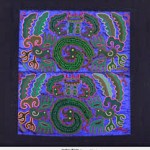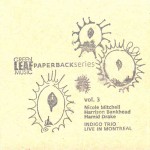©Laurence Svirchev
Indigo is one of the more beautiful colors that human ingenuity has refined from nature. From ancient times the peoples of western Afrika, China, and Japan succeeded in extracting indigo dye from the plant of the same name. The Yoruba of Nigeria and the Manding of Mali were known to have extraordinary facilities in combining the dye with textiles to create exquisite woven cloth. Until the invention of blue jeans, those who wore indigo-dyed clothes were typically the royalty and privileged of many ancient societies.
 Indigo is dark and cool, yet it possesses energy-generating luminosity. When other colors are woven through or on top of an indigo-based fabric, the cloth becomes resplendent. The fabric in the photo comes from Guizhou, a southern province in China. Note the shades of blue that flow from the deep indigo, how the greens, reds, and golds shimmer. It’s all because of the indigo base.
Indigo is dark and cool, yet it possesses energy-generating luminosity. When other colors are woven through or on top of an indigo-based fabric, the cloth becomes resplendent. The fabric in the photo comes from Guizhou, a southern province in China. Note the shades of blue that flow from the deep indigo, how the greens, reds, and golds shimmer. It’s all because of the indigo base.
The power of color was not lost on the English scientist-philosopher Isaac Newton (1643-1727). He believed that sound and light were physically similar. He postulated that indigo was one of the seven primary colors matching the seven notes of the western major musical scale. The other primaries in Newton’s spectrum were red, orange, yellow, green, blue, and violet. Newton must have had exceptionally fine acute vision, because his schema differentiated indigo from the its close cousins blue and violet. Newton’s mind, stewed in alchemy and cabbalism as well as scientific rigor, was not known to be a practicing musician but maybe he should have been.
Expertise with indigo had its down-side, however. Clarinetist and composer John Carter eloquently pointed out in his liner notes to Castles of Ghana (Gramavision, out of print) that west African princes collaborated with European traders in exporting Africans by the boat-load to the plantations New World for what he called “permanent detention and generally for purposes of uncompensated labor.” Cotton was not the only crop that propelled international economies based on slavery. Indigo plantations were big business in colonial Jamaica and South Carolina.
The people whose hands were drenched in indigo dye also brought their music to America, a music that over the course of centuries developed into the distinctive Afro-American forms of blues, spirituals, and jazz. The blues could have been rightfully called the “indigoes”, but that is not the way it happened even though Duke Ellington’s 1931 “Mood Indigo” had a lyric that contained an apt description “bluer than blue” that Isaac Newton might have appreciated.
 Which brings me to the Indigo Trio, Live in Montréal. The opening two cuts are ritualistic in nature. First comes a welcoming to an intimate but perhaps unknown terrain. Then comes a thankfulness, a prayer for being kindly received in this new place. These cuts act as a prelude in a journey to a continent, a jazz bar, and an exhortation to stand strong in the face of oppression. The individual compositions segue from one to another with no time gaps. This reinforces the sense of passage from one place or mood to another. The communication among the musicians suggests that the Indigo Trio has been functioning as a unit for a long time. Not so, for although each of the players had made music with each other in the past, this is their first trio configuration.
Which brings me to the Indigo Trio, Live in Montréal. The opening two cuts are ritualistic in nature. First comes a welcoming to an intimate but perhaps unknown terrain. Then comes a thankfulness, a prayer for being kindly received in this new place. These cuts act as a prelude in a journey to a continent, a jazz bar, and an exhortation to stand strong in the face of oppression. The individual compositions segue from one to another with no time gaps. This reinforces the sense of passage from one place or mood to another. The communication among the musicians suggests that the Indigo Trio has been functioning as a unit for a long time. Not so, for although each of the players had made music with each other in the past, this is their first trio configuration.
The “Welcoming” opens as an arco solo by Harrison Bankhead on cello. The cadence is slow, the emotion is solemn. It feels rural, from a time when communities were small, the pace of living and dying was steady like the changing of seasons, when the land was filled not with concrete but with trees, and when the entire village would turn out when a visitor approached or someone who had been away returned.
When Nicole Mitchell enters this unstrange land, she colors and supports Bankhead’s lead. Gradually the flute and bass lines intertwine, either musician suggesting a slight change in pitch or a slight acceleration or deceleration which the other immediately takes up. Hamid Drake stays pretty much in the background, coloring the music on wire brushes. The beauty of “Welcoming” is followed by another composition glowing with warmth, “Thankfulness.”
The third composition “Afrika Rising” tells a story quite different from the two preceding compositions. It begins with drama, Mitchell’s fleet flute work stating refrains that suggest something portentous lies ahead. The feeling is enhanced by Bankhead’s ultra-deep bass-line, something not only heard but felt, as if the listener’s body were vibrating at the same low frequency as the earth’s.
The pre-indication of something felt-not-seen turns into a momentum of express-train urgency. Until this point in the concert, Drake has pretty much confined himself to brushes. With “Afrika Rising” he turns to the sticks and the concert moves into a different dynamic.
The drum kit composed of ride, crash and high-hat cymbals, tom-tom, snare, and bass drums is one of the more amazing American inventions. It allows one person to simultaneously proceed with four independent rhythms. Drake is one of those drummers who can make the kit sound like an African percussion choir in the context of an American jazz aesthetic.
Drake does this with a vast array of devices. Some of these include well-timed shots to the cymbals, crashes that decay without further intervention while he rotates his attention to the tom-toms. That adds depth and defined pulse. When he wants to add some straight time-keeping, he frequently uses rim shots on the snare drum. And on occasion he will use repeated one-two, one-two sometimes off-kilter high-hat snick-snicks, let a moment of silence sneak in, seal the kiss with a mighty strike to a crash cymbal, then let the affair decay while he attends to other business. The result is a polyrhythmic powerhouse drumming. Drake uses all these devices on “Afrika Rising.” (They were also some of the signature techniques of the great Abdullah Ibn Buhaina, Art Blakey, who put together his attack in the years after his late-1940s visit to Africa).
One of the more common generic definitions of jazz is the combination of European instrumentation with African rhythms. Jazz itself has become incredibly variegated in the last fifty years. Dizzy Gillespie was perhaps the most prominent musician who consciously brought the Cuban mode of rhythm into the music. In today’s world, the eighty year-old Randy Weston is perhaps the eminent elder who still speaks to the African roots of the music.
In the Sixties, the music expanded into the realms of free music which in turn melded into more abstract forms. In today’s international jazz world, many forms coexist yet even the master musicians who play in the most abstract modes will inevitably trace their first sparks of creativity back to inspiration from classic Afro-American jazz. In spite of this, an African aesthetic in jazz, is startlingly under-used in contemporary jazz.
This is where the Indigo Trio stands out. The trio’s music takes the listener all the way back to the sources of jazz without sounding old. At the same time it is a highly emotional contemporary music, using modern techniques, that drive straight to the pulse of the human heart.
Live in Montréal speaks to the pulse and spirit of African music connected to the contemporary American experience. Every track provokes body motion. But that motion is not felt by this reviewer as a the dance of an individual but rather the dance of collective motion, be it the slow sway of an ancient ceremony or the high energy urban tempo of the “Velvet Lounge Bounce.”
This is a music made by people who have the shaman spirit inside them, musicians who excite an audience into high energy states.
The Indigo Trio [performs Saturday, July 1 at the TD Canada Trust Vancouver International Jazz Festival. For details, click here:
http://www.coastaljazz.ca/index.cfm?page_id=97&view=DETAILS&event_id=775
Post-script: “Afrika Rising” is the first movement of the Afrika Rising Trilogy. The Afrika Rising Trilogy can be found on a Dreamtime Records CD. Nicole Mitchell has pointed out that people from that variegated land pronounce the continent’s European-derived name with a soft-soft-hard flow.